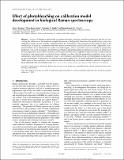| dc.contributor.author | Barman, Ishan | |
| dc.contributor.author | Kong, Chae-Ryon | |
| dc.contributor.author | Singh, Gajendra P. | |
| dc.contributor.author | Dasari, Ramachandra Rao | |
| dc.date.accessioned | 2011-07-28T15:46:43Z | |
| dc.date.available | 2011-07-28T15:46:43Z | |
| dc.date.issued | 2011-01 | |
| dc.date.submitted | 2010-05 | |
| dc.identifier.issn | 1083-3668 | |
| dc.identifier.uri | http://hdl.handle.net/1721.1/64970 | |
| dc.description.abstract | A major challenge in performing quantitative biological studies using Raman spectroscopy lies in overcoming the influence of the dominant sample fluorescence background. Moreover, the prediction accuracy of a calibration model can be severely compromised by the quenching of the endogenous fluorophores due to the introduction of spurious correlations between analyte concentrations and fluorescence levels. Apparently, functional models can be obtained from such correlated samples, which cannot be used successfully for prospective prediction. This work investigates the deleterious effects of photobleaching on prediction accuracy of implicit calibration algorithms, particularly for transcutaneous glucose detection using Raman spectroscopy. Using numerical simulations and experiments on physical tissue models, we show that the prospective prediction error can be substantially larger when the calibration model is developed on a photobleaching correlated dataset compared to an uncorrelated one. Furthermore, we demonstrate that the application of shifted subtracted Raman spectroscopy (SSRS) reduces the prediction errors obtained with photobleaching correlated calibration datasets compared to those obtained with uncorrelated ones. | en_US |
| dc.description.sponsorship | National Center for Research Resources (U.S.) (Grant P41-RR02594) | en_US |
| dc.description.sponsorship | Bayer Healthcare | en_US |
| dc.description.sponsorship | Massachusetts Institute of Technology. Laser Biomedical Research Center. Lester Wolfe Fellowship | en_US |
| dc.language.iso | en_US | |
| dc.publisher | Society of Photo-optical Instrumentation Engineers (SPIE) | en_US |
| dc.relation.isversionof | http://dx.doi.org/10.1117/1.3520131 | en_US |
| dc.rights | Article is made available in accordance with the publisher's policy and may be subject to US copyright law. Please refer to the publisher's site for terms of use. | en_US |
| dc.source | SPIE | en_US |
| dc.title | Effect of photobleaching on calibration model development in biological Raman spectroscopy | en_US |
| dc.type | Article | en_US |
| dc.identifier.citation | Barman, Ishan et al. “Effect of Photobleaching on Calibration Model Development in Biological Raman Spectroscopy.” Journal of Biomedical Optics 16.1 (2011) : 011004. © 2011 Society of Photo-Optical Instrumentation Engineers (SPIE) | en_US |
| dc.contributor.department | Massachusetts Institute of Technology. Laser Biomedical Research Center | en_US |
| dc.contributor.department | Massachusetts Institute of Technology. Spectroscopy Laboratory | en_US |
| dc.contributor.approver | Dasari, Ramachandra Rao | |
| dc.contributor.mitauthor | Barman, Ishan | |
| dc.contributor.mitauthor | Kong, Chae-Ryon | |
| dc.contributor.mitauthor | Dasari, Ramachandra Rao | |
| dc.relation.journal | Journal of Biomedical Optics | en_US |
| dc.eprint.version | Final published version | en_US |
| dc.type.uri | http://purl.org/eprint/type/JournalArticle | en_US |
| eprint.status | http://purl.org/eprint/status/PeerReviewed | en_US |
| dspace.orderedauthors | Barman, Ishan; Kong, Chae-Ryon; Singh, Gajendra P.; Dasari, Ramachandra R. | en |
| mit.license | PUBLISHER_POLICY | en_US |
| mit.metadata.status | Complete | |
